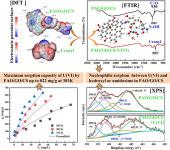Journal of Environmental Chemical Engineering ( IF 7.7 ) Pub Date : 2021-09-11 , DOI: 10.1016/j.jece.2021.106363 Shuai Zhou 1, 2 , Yanxing Xie 2 , Feiyu Zhu 3 , Yuanyuan Gao 3 , Yingjiu Liu 1, 2 , Zhenping Tang 3 , Yi Duan 1, 2

|
Graphene oxide (GO) and its composites are promising candidates for the adsorption of U(VI) in water. Whereas the high hydrophobicity and dispersibility of GO makes it hard to separate from aqueous solutions, and thus greatly restricts its practical application. To address this defect, a novel composite [i.e., poly(amidoxime)/GO/chitosan (PAO/GO/CS)] was prepared. Characterization including Fourier transform infrared spectroscopy, X-ray diffraction, and X-ray photoelectron spectroscopy confirmed that cross-linking reaction between GO and CS may consume oxygen-contained groups of GO. The resulting deficit in U(VI) adsorption may be compensated by the amidoxime grafted onto the surface of GO/CS. Langmuir model showed that the maximum adsorption capacity of U(VI) by PAO/GO/CS was up to 701.5, 821.7, and 1220.0 mg/g, respectively, under 293, 303, and 313 K at pH 6.0. U(VI) is spontaneously and mainly chemically adsorbed onto the oxygen-containing groups (i.e., hydroxyl and amidoxime) in PAO/GO/CS based on characterization and density functional theory (DFT). DFT analysis indicated that the optimized adsorption energy of most stable configuration of the uranyl-PAO/GO/CS is −309.99 kcal/mol. PAO/GO/CS can achieve selective adsorption for U(VI) against common coexisting ions and superior separation from water. These findings demonstrate the feasibility of PAO/GO/CS composite used for the remediation of uranium-containing wastewater.
中文翻译:

胺肟改性壳聚糖/氧化石墨烯复合材料可有效吸附水溶液中的 U(VI)
氧化石墨烯(GO)及其复合材料是吸附水中U(VI)的有希望的候选材料。而GO的高疏水性和分散性使其难以从水溶液中分离,从而极大地限制了其实际应用。为了解决这个缺陷,制备了一种新型复合材料 [即,聚(酰胺肟)/GO/壳聚糖(PAO/GO/CS)]。包括傅里叶变换红外光谱、X 射线衍射和 X 射线光电子能谱在内的表征证实,GO 和 CS 之间的交联反应可能会消耗 GO 的含氧基团。U(VI) 吸附的不足可以通过接枝到 GO/CS 表面的胺肟来补偿。Langmuir 模型表明,在 293、303、和 313 K,pH 6.0。基于表征和密度泛函理论 (DFT),U(VI) 自发且主要以化学方式吸附到 PAO/GO/CS 中的含氧基团(即羟基和胺肟)上。DFT 分析表明,铀酰-PAO/GO/CS 最稳定构型的优化吸附能为 -309.99 kcal/mol。PAO/GO/CS 可以实现对 U(VI) 对常见共存离子的选择性吸附和与水的卓越分离。这些发现证明了 PAO/GO/CS 复合材料用于修复含铀废水的可行性。DFT 分析表明,铀酰-PAO/GO/CS 最稳定构型的优化吸附能为 -309.99 kcal/mol。PAO/GO/CS 可以实现对 U(VI) 对常见共存离子的选择性吸附和与水的卓越分离。这些发现证明了 PAO/GO/CS 复合材料用于修复含铀废水的可行性。DFT 分析表明,铀酰-PAO/GO/CS 最稳定构型的优化吸附能为 -309.99 kcal/mol。PAO/GO/CS 可以实现对 U(VI) 对常见共存离子的选择性吸附和与水的卓越分离。这些发现证明了 PAO/GO/CS 复合材料用于修复含铀废水的可行性。


























 京公网安备 11010802027423号
京公网安备 11010802027423号